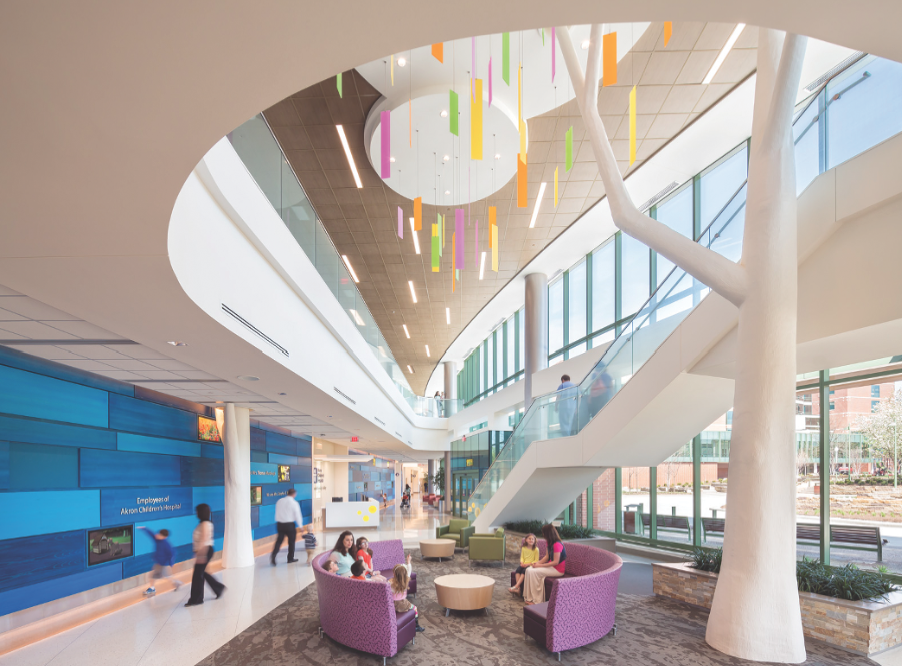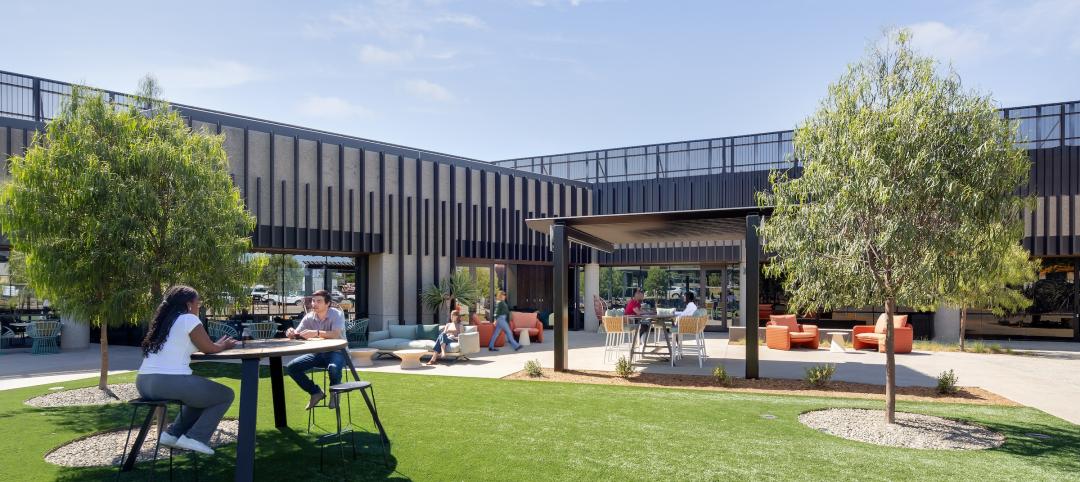Construction of hospitals and medical offices is expected to shake off its lethargy in 2015 and recover modestly over the next several years, as healthcare systems vie for patients who want the latest and most convenient services and technologies.
Hospital construction revenue should grow by 3.8% this year, to $20.3 billion, according to market research firm IBISWorld. Renovation and expansion projects will account for about 73% of total healthcare-related construction.
TOP HEALTHCARE SECTOR ARCHITECTURE FIRMS
2014 Healthcare Revenue ($)
1. HDR $198,699,134
2. Stantec $144,447,155
3. Perkins+Will $104,690,000
4. HKS $103,811,878
5. CannonDesign $95,000,000
TOP HEALTHCARE SECTOR ENGINEERING FIRMS
2014 Healthcare Revenue ($)
1. AECOM $458,485,000
2. Jacobs $93,920,000
3. Burns & McDonnell $42,896,090
4. KPFF Consulting Engineers $37,500,000
5. Smith Seckman Reid $35,847,890
TOP HEALTHCARE SECTOR CONSTRUCTION FIRMS
2014 Healthcare Revenue ($)
1. Turner Construction $2,109,854,708
2. McCarthy Holdings $1,181,270,640
3. Skanska USA $1,070,841,424
4. Brasfield & Gorrie $995,112,893
5. JE Dunn Construction $751,273,218
HEALTHCARE GIANTS SPONSORED BY:
In Florida, where healthcare construction is up 20% from 2010, DPR Construction recently started on the 33,000-sf Gloria Drummond Physical Rehabilitation Institute for Boca Raton Regional Hospital. Working with architect HKS, the contractor is renovating existing therapy spaces, upgrading exterior features, and adding an aquatic therapy center.
In May, Akron (Ohio) Children’s Hospital opened its $180 million Kay Jewelers Pavilion, a seven-story, 368,735-sf addition that includes a 39-bed expanded emergency department, a neonatal ICU with 75 private rooms, and a new outpatient center and special delivery unit for high-risk newborns.
Patients’ families and staff helped design the pediatric hospital. “Project teams addressed such issues as minimizing walking for patient families, doctors, and nurses, ensuring efficient movement of supplies in and out of operating rooms, and providing a calm environment that promotes privacy,” says Jeff Stouffer, AIA, ACHA, EVP and Healthcare Group Director for HKS, the project’s designer.
Medical office building starts should also experience an uptick this year, following a period when MOB construction dropped to 3.7 million sf in the first half of 2014, from 7.7 million sf in the first half of 2009, according to Colliers International.
“Strong demand for modern, flexible space will spur development of new medical office buildings concentrated near dominant hospitals and health systems and targeted population groups,” Colliers predicts. The research firm says developers are likely to favor new MOB construction over retrofits of older properties.
The healthcare facilities sector continues to adjust construction and renovation plans to meet consumer demands for flexible services. Clay Seckman, PE, Senior Principal with engineering firm Smith Seckman Reid (SSR), sees a migration of healthcare services to lower-cost outpatient settings, “where patients receive quality diagnostic and treatment without the ‘institutional’ feel.”
Colliers notes that pharmacies and supermarkets are elbowing their way into the healthcare arena, offering such services as vaccinations and treatment for common, non-acute illnesses. Kaiser Permanente, California’s largest HMO, recently entered into a partnership with Target to open clinics inside several of the retailer’s stores in Southern California. Minute Clinics, the leader in the retail clinic market, with more than 900 locations, intends to open 600 more through 2017.
WIDENING THE CLIENT BASE
Hospital systems must now figure out how to keep pace with growing demand from two sources: first, the 32 million Americans who have healthcare coverage under the Affordable Care Act; and, second, the seniors cohort, which is expected to swell by two-thirds through 2035.
To meet demand, hospitals are adding beds. Seckman says that increasing inpatient bed capacity was a motivating factor behind SSR’s $500 million, two-million-sf campus replacement project at CHI St. Luke’s Health in Houston. An SSR renovation at Lee Memorial Health System in Fort Myers, Fla., reactivated decommissioned beds.
Despite its growth potential, the healthcare sector remains volatile. Twenty hospitals declared bankruptcy last year, in some cases to make their assets more attractive acquisition targets. Colliers thinks this pattern could continue for the next five to seven years, “as weaker systems are unable to compete with larger, more financially sound systems seeking to capture greater market share and influence.”
Some healthcare systems are also closing older hospitals in poorer areas so they can open new facilities in more affluent markets with more insured patients.
Hospitals and other medical facilities are often viewed as engineers of neighborhood economic and social vitality. In San Francisco, construction of the $2 billion, 700,000-sf California Pacific Medical Center is spurring developers and property owners to line up projects near the hospital that, if approved, would result in 2,000 new housing units, a million sf of office space, and hundreds of hotel rooms.
HKS’s Stouffer sees hospitals “becoming catalysts for change in communities, beginning with urban planning, mixed-use design, and improving the patient and family experience.” He believes care will also be moving to the patient’s home, thanks to advances in technology linking the patient to the physician, hospital, or clinic.
McCarthy’s Gritters on hot trends in healthcare facilities
Current hospital design and construction trends noted by Michael Gritters, EVP, McCarthy Building Companies:
• Hybrid operating rooms with intra-operative MRIs
• Adjustable and easily upgradable surgical suites
• Decentralized nurses’ stations at bedside or immediately outside the patient’s room
• More homelike environments for patients
• Collaborative design and construction methods that emphasize safety, quality, shorter schedules, and lower costs
RETURN TO THE GIANTS 300 LANDING PAGE
Related Stories
MFPRO+ New Projects | Oct 30, 2024
BIG’s One High Line finally reaches completion in New York City’s West Chelsea neighborhood
One High Line, a luxury residential project spanning a full city block in New York’s West Chelsea neighborhood, reached completion this summer following years of delays related to investor lawsuits.
Urban Planning | Oct 30, 2024
Bridging the gap: How early architect involvement can revolutionize a city’s capital improvement plans
Capital Improvement Plans (CIPs) typically span three to five years and outline future city projects and their costs. While they set the stage, the design and construction of these projects often extend beyond the CIP window, leading to a disconnect between the initial budget and evolving project scope. This can result in financial shortfalls, forcing cities to cut back on critical project features.
MFPRO+ New Projects | Oct 30, 2024
Luxury waterfront tower in Brooklyn features East River and Manhattan skyline views
Leasing recently began for The Dupont, a 41-story luxury rental property along the Brooklyn, N.Y., waterfront. Located within the 22-acre Greenpoint Landing, where it overlooks the newly constructed Newtown Barge Park, the high-rise features East River and Manhattan skyline views along with 20,000 sf of indoor and outdoor communal space.
Libraries | Oct 30, 2024
Reasons to reinvent the Midcentury academic library
DLR Group's Interior Design Leader Gretchen Holy, Assoc. IIDA, shares the idea that a designer's responsibility to embrace a library’s history, respect its past, and create an environment that will serve student populations for the next 100 years.
Resiliency | Oct 29, 2024
Climate change degrades buildings slowly but steadily
While natural disasters such as hurricanes and wildfires can destroy buildings in minutes, other factors exacerbated by climate change degrade buildings more slowly but still cause costly damage.
Office Buildings | Oct 29, 2024
Editorial call for Office Building project case studies
BD+C editors are looking to feature a roundup of office building projects for 2024, including office-to-residential conversions. Deadline for submission: December 6, 2024.
Healthcare Facilities | Oct 28, 2024
New surgical tower is largest addition to UNC Health campus in Chapel Hill
Construction on UNC Health’s North Carolina Surgical Hospital, the largest addition to the Chapel Hill campus since it was built in 1952, was recently completed. The seven-story, 375,000-sf structure houses 26 operating rooms, four of which are hybrid size to accommodate additional equipment and technology for newly developed procedures.
Multifamily Housing | Oct 28, 2024
A case for mid-rise: How multifamily housing can reshape our cities
Often referred to as “five-over-ones,” the mid-rise apartment type is typically comprised of five stories of apartments on top of a concrete “podium” of ground-floor retail. The main criticism of the “five-over-one” is that they are often too predictable.
Sports and Recreational Facilities | Oct 24, 2024
Stadium renovation plans unveiled for Boston’s National Women’s Soccer League
A city-owned 75-year-old stadium in Boston’s historic Franklin Park will be renovated for a new National Women’s Soccer League team. The park, designed by Fredrick Law Olmsted in the 1880s, is the home of White Stadium, which was built in 1949 and has since fallen into disrepair.
Laboratories | Oct 23, 2024
From sterile to stimulating: The rise of community-centric life sciences campuses
To distinguish their life sciences campuses, developers are partnering with architectural and design firms to reimagine life sciences facilities as vibrant, welcoming destinations. By emphasizing four key elements—wellness, collaboration, biophilic design, and community integration—they are setting their properties apart.


















